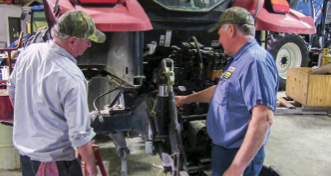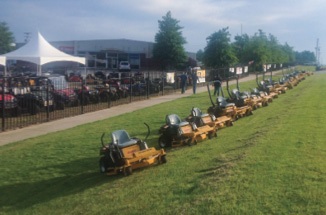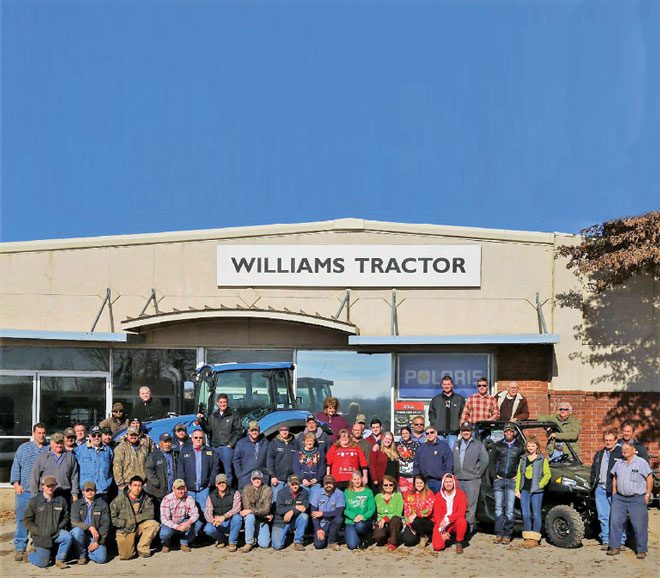Pictured Above: Williams Tractor serves a diversified customer base, including rural lifestyle, lawn and garden, cattle and poultry producers, construction, outdoor powersports and row-crop farmers. The management team is planning for expansion.
Williams Tractor
Founded: 1973
Locations: Fayetteville, Berryville, Rogers and McGehee, Ark., and Rayville, La.
Lines: New Holland, Case IH, Kioti, Bush Hog, Woods, Rhino, Big Dog, Bad Boy, Bobcat, Polaris, Kawasaki, Yamaha, Suzuki, KTM, Kymco, Haybuster, Vermeer, Hustler, Terex and Landoll
Business System: DIS
Challenge & Solution: Maintaining positive off-season cashflow in the service department by offering diverse products and aggressively pursuing high machine populations.
One of the biggest decisions facing dealerships revolves around setting fair equipment margins. If high profit is the goal, sales may be lost to competitors, but aggressive pricing could lead some to feel they could have done better.
Williams Tractor, a Fayetteville Ark.-based dealership with 7 locations, has chosen to focus on maintaining large machine populations and numbers of customers. That path includes cutting margins to marketplace leaders, maintaining high visibility and using rental programs as an alternative to offset the high purchase price of some machines.

Doug Williams is the second-generation owner of Williams Tractor. He owns the dealership with his brother Dwight and first cousin, Gary Tollett. Their 7-store group stretches from the hills of northwest Arkansas to the Louisiana delta.
They see the byproducts of high market share as increased promotion for their products, more aftermarket revenue and fewer worries about seasonality. These benefits more than offset any potential margin losses. While admitting that more sales can bring more headaches, they aim for an empowered staff to quickly resolve customer issues. Before we examine their path to having a shop that’s two weeks behind in the dead of the winter, let’s look at the background of the dealership.
Location Gives Advantages
Williams Tractor is a diversified dealer organization, with two power sports stores, two locations devoted to row-crop farmers, a construction-only store and their first two dealerships that cater to rural lifestyle customers and livestock producers.
At a time when many large multi-store dealership groups are corporately owned, Williams Tractor is owned by Doug Williams, his brother Dwight Williams and their first cousin, Gary Tollett. The dealership will likely top $140 million in total sales in 2016.
It would be difficult to find a better place in North America other than Northwest Arkansas to locate a rural lifestyle dealership. The rugged hills are scenic, but were not overly blessed with wealth a century ago. Mostly too rough for row-crop farming, the area was home to modest dairies, beef cattle producers and poultry operations. Then the boom hit.
Dealer Takeaways
- Machine population is critical to the health of the dealership. High numbers can reduce seasonality challenges, enhance product visibility and lead to solid long-term parts and service business.
- It may be important to cut margins to attract market leaders on certain products because maintaining high visibility is critical to growth in some product areas.
- Using rental programs can open doors to expanding opportunities for sales in that product segment. Think of it as a “paid demo.”
Three companies led the influx of wealth to the area about 45 years ago: J.B. Hunt, Tyson and Walmart. With the world headquarters of all three in a small geographic circle, equipment dealers in the area prospered and among them, at that time, was Williams Ford, located in Fayetteville, Ark. The dealership was owned by Don Williams, Doug’s father, who bought the dealership from an acquaintance in 1973. His sons, Doug and Dwight, joined the operation in 1988 and bought their father out in 2000.
Doug Williams credits much of the dealership’s success to the great location. “Probably not very many areas in the U.S. have been so insulated from the ups and downs of the economy. It’s been up for 25 years, even in the recession that we had in 2007, our ‘down’ was not nearly as down as 95% of the country, so we’re very blessed to be in Arkansas,” Williams says.
Today, Williams Tractor stretches from the hills of the northwest part of the state to the rich agricultural areas in the southern Arkansas delta and into Louisiana.
In 2014, the addition of Gary Tollett fueled expansion. Tollett had divested from a successful group of animal health distributors and was looking for a business to invest in. He brought with him capital and a desire for additional growth.
“Sell as much as you can and, usually, the margins will take care of themselves...”
– Doug Williams, Williams Tractor
Doug handles the operations side of the business. Dwight manages the Rogers, Ark., stores, and Tollett focuses on financials, along with looking for opportunities to grow and utilize economies of scale.
Expanding the Dealership
The home store offers New Holland, Case IH and Kioti tractors; Bobcat and New Holland construction equipment; Polaris powersports products; Hustler, Big Dog and Bad Boy zero-turn mowers; Woods Equipment; Rhino; Bush Hog; and numerous other short lines. A second location was added in 1990, in Berryville, Ark., catering mostly to the buyers of less than 100 horsepower equipment.
There are two Williams’ stores located side-by-side in Rogers, Ark., a powersports-only Polaris dealership, Freedom Powersports, purchased in 2005, and Bobcat of Northwest Arkansas, built the following year, offering Bobcat and New Holland construction equipment.
A second Freedom dealership was added in Fayetteville in 2015, handling Kawasaki, Yamaha, Suzuki, KTM and Kymco. Also, in 2015, the South Ark Equipment stores were added in McGehee, Ark., and Rayville, La. Those locations handle New Holland and Landoll equipment to serve the area’s row-crop farmers.
Focusing on Sales
Williams’ business philosophy is very sales-oriented. “We know you have to have machines out there to keep the service guys busy. Winter is a prime example of that. If you don’t have equipment coming in and all you’re doing is working on your own stuff, how do you pay the bills?
“I came into a philosophy that was already here of trying to sell as much as you can and, usually, the margins will take care of themselves. People will let you make a little money, but on the other hand, I know exactly how much I make if the competition sells a new tractor and I don’t. I penciled that out years ago. It’s not just what you missed that first day, it’s what you miss 3 years after the initial sale, or 10 years after. You need that population of older machines to keep the service work coming,” he says.
So where is the “sweet spot” for margins — the place where you sell the maximum amount of units without leaving money on the table? Williams says it’s different on every product. “You have to make a certain margin on lawn mowers, higher than you do on a 100 horsepower tractor. You can live with a really close margin on that tractor, because you just know that you’ll make it up in service down the road. You can live with a smaller margin on hay equipment, because those things, by nature, are good for the service department.
“Weekend farmers are not going to go out there and tear a compact tractor up, so you need to make a decent margin when you sell it. You can’t just give the tractor away; you might not see that guy again for 10 years. He may come in 5 years from now for his 100-hour oil change, so we can’t live on the service of that weekend guy. So, the margin we’ll take varies by product,” Williams says.

The Williams Tractor team follows a philosophy of maintaining high market share and large machine populations, which helps the shop avoid seasonal gaps in workload and maintain a positive cashflow. Service manager Randy Huck (right) and technician Marty London (left) discuss repairs on a tractor.
He sees the zero-turn mower market as an opportunity to attract new customers. Williams advises that anyone wanting to increase their footprint in that market should maintain an aggressive philosophy when selling to selected customers.
“If I’m in an area with commercial mowing contractors, I’m going to try to identify the players and go get their business. If I have to give them a lawnmower, margin-wise, they’re going to own my mower, especially if I’m confident in my product.
“So we get those key players, the market sees what they’re using and the homeowners start coming in. That’s our philosophy. Residential mower customers become candidates for future sales. Zero-turn mowers drive sales for tractors on down the road,” Williams says.
The dealership’s main mower brand is Hustler and, highlighting how much importance he places on dominating that market, he’s been honored as their top volume dealer in North America multiple times. He adds, “I don’t know if we’re still there, but we’re in the top 4 or 5. We sell over 700 a year.”
Those numbers, in turn, equate to shop work. “If you try to bring us your lawnmower during January, our service manager is going to tell you we’re going to get to it as fast as we can, but it may be about 2 weeks. We’ve been very fortunate to have a great market share in mowers,” he says.
“You can’t do it all yourself and that’s the hardest part, letting go of control, but you have to...”
– Doug Williams, Williams Tractor
The approach is a little more difficult with powersports sales. Williams says that the secret is to locate groups of pure enthusiasts and aggressively pursue their business.
“The way to do that is find out where these guys are going, then make yourself and your product seen in areas where everybody rides, which will be a different type of place for every area. If there are 50 machines out riding a trail this weekend, we want half of them to be ours, at least,” he says.
Selling small tractors is more difficult because of the diversity of the client base. “You can’t just pick a key player and go after them, because those guys don’t exist, at least they don’t in northwest Arkansas. So, it’s a marketing play and you have to find ways to get your brand of compact tractors in front of your market and that’s difficult.
“We’ve tried different ways of advertising in our area and we’ve found that some of the ‘shoppers’ publications weren’t good. We’ve also tried to put package deals together to get people’s attention,” he says.
Rental Strategies
Williams says the best method he’s found to promote compact tractors is by offering rental. “We’ve always looked at it as a paid demonstration. So, instead of me going out to your place and demoing a tractor for free, you’re coming to me and renting my machine that, hopefully, you’ll be impressed with and want to own. We try to do as much rental as we can and we think we can do more in that area,” Williams says.
Some dealers shy away from the rental business, dreading arguments with customers if the machines are returned with damage. Williams says that an extra effort before the machine leaves the dealership will prevent later issues. “You have to handle that on the front end and have a process in place. You have a walk-around and take pictures before the rental. There’s a little more to it than just handing somebody the keys. If these issues are addressed beforehand, they don’t become a big problem when they do happen,” he says.
Williams says a big key to success in rental is using the manufacturer-sponsored programs that encourage the practice. “We set up a rental yard, so we get discounts that aren’t available to the average consumer, so the products are a little less money going in there. The suppliers have rules on how long the units have to stay in rental, so we find out what that minimum retention date is and we start marketing that machine a month before the retention comes up. So, hopefully when that 6 or 12 months is up, we have a buyer for that machine already. And we just roll another one in there,” he says.
Once the machines cycle out of the fleet, they become attractive to a large audience who may be looking for late model trades, which are fairly rare. “One thing we do about every month is evaluate our rentals. We look at what’s in the rental fleet today that we can sell in the next 30-60 days and what’s there that should have been sold 2 months ago. Then, we look at what we have to do marketing-wise for the next 2 months and adjust accordingly,” he says.

Allowing lower margins on zero-turn mowers for large commercial contractors may build sales and yield greater visibility for the product and lead to increased homeowner sales.
Promoting the Dealership
Williams is also spending a lot of time in the winter booking his advertising promotions for the coming rush. “This time of year, we set up how much money we’re going to spend in print and on TV and what products we’re going to advertise over the coming 12 months. Social media’s become a big place that we try to make sure we’re out there in front of everybody. We’re utilizing Craigslist; websites such as TractorHouse.com; and Farm Talk, a regional weekly agricultural newspaper, to make sure we have all of our used products advertised,” he says.
Adding Employees
Growing a business requires good employees. Williams Tractor now employs 170 people and the upper management staff has been part of the dealership for a number of years. “Loyalty in this industry seems to be pretty good, especially with our business. We try to be fair with people and give them opportunities to make some money and advance in the company if an opportunity opens up.
“Going forward, I see finding employees as becoming a problem. As we get further away from rural backgrounds, and from kids that grew up on farms and knew how to work every day, it’s going to become more of a challenge to get people with the work ethic that we’ve had in the past,” Williams says.
A growing market share can bring about more challenges and that’s where having a well-trained staff is critical. Williams admits, “You can’t do it all yourself and that’s the hardest part about running a dealership like this, letting go of control, but you have to. If you’re going to increase that population of customers and machines, you’re going to increase the number of problems, too, so if you try to handle them all yourself, you’re going to drive yourself nuts,” he says.
Finding Opportunities
Williams says he has the ability to “turn off” the business at the end of each day and not take problems from the dealership home with him. He believes the future of the business is in more expansion.
Williams says that a “buyer’s market” currently exists for equipment dealerships, brought on by farm economy difficulties and the age of many owners, and he and Tollett are positioning the dealership group for growth. They are looking for the right opportunities to expand their footprint and continue increasing the number of customers they serve through the number of machines they send to the field.






Post a comment
Report Abusive Comment